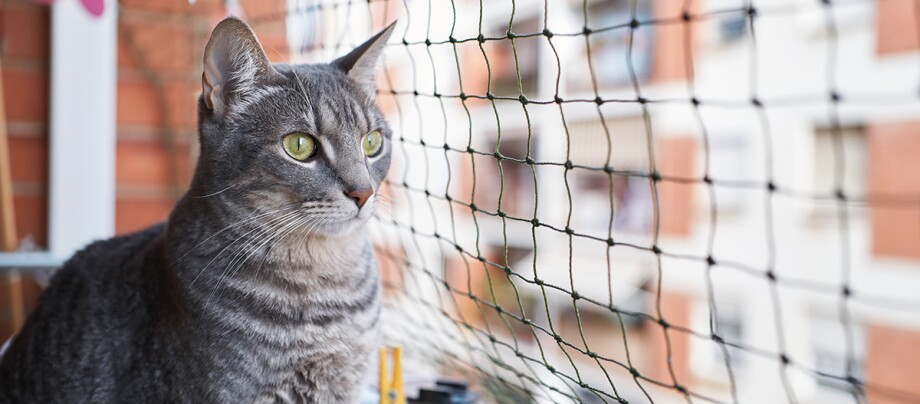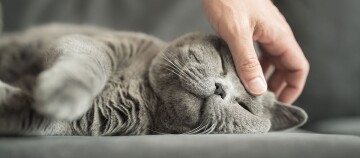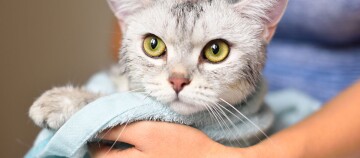Make your balcony safe for your cat
11.03.2025 - Reading time: 2 minutes

Auf einem katzensicheren Balkon kann deine Samtpfote ganz entspannt frische Luft schnappen, ohne sich selbst in Gefahr zu bringen.
Daniel Lozano Gonzalez / Moment via Getty Images
From a cat's perspective, being outdoors is an exhilarating way to spend the day. However, for various reasons, not all cats can be given this freedom. In city center apartments with heavy traffic, keeping cats indoors is often safer. Providing a cat with access to a balcony is an excellent compromise, allowing them to enjoy the fresh air safely. The keyword here is "secure": Make your balcony cat-proof.
What advantages does a balcony have for cats?
An indoor cat can enjoy a fulfilling, relaxed life at home with suitable equipment, food, entertainment, and healthcare.
.
A balcony can be a great area for indoor cats to enjoy the outdoors safely:
- Noises: Birdsong, children playing, and other sounds provide exciting auditory stimulation.
- Weather: The ever-changing weather – wind, warm sunshine, snow – adds excitement to a cat’s life.
- Smells: With our limited sense of smell, it’s difficult for us as humans to comprehend the range of scents and odours our cats can detect in the open air.
- Watching: Birds, leaves, passers-by, and cars can entertain your cat from the balcony. A good view can also intellectually stimulate them.
- Hunting: Flies or leaves catching your cat’s attention can be more exciting than any soft toy.
But remember, safety is the top priority, which is why cat-proofing your balcony is essential.
Why do I need to cat proof my balcony?
Cat-proofing a balcony fences off the area, providing safety and security for your pet. This helps prevent sudden escapes or falls. Even agile cats can face dangerous adventures like climbing to the next floor or roof. The main role of cat-proofing is to prevent accidents. A startled cat might escape to the balcony or leap into the air trying to catch a bird. Weak points like spaced balcony railings or doors pose risks too.
Accessories and cat proofing the balcony: What do I need to consider?
Cat-proofing your balcony depends on property management or residents’ association rules. Building regulations may limit what you can do, such as attaching hooks to exterior walls or altering the block’s view.
Once you have permission, there are different ways to cat proof your balcony:
- Cat netting: Netting comes in various sizes. For agile, slim cats, 3 to 4 cm gaps work best; for larger or older cats, 5 cm gaps are fine. Ensure the netting completely encloses the balcony, usually with hooks and tensioning rope.
- Visual protection: Weave a bamboo mat between railings with large gaps to act as a barrier.
- Securing balcony doors: Use locks or block half-open access to prevent your cat from escaping. Never leave a pet unattended with doors or windows ajar.
- Cat flaps: Install a cat flap in glass doors with the help of a glazier, allowing your cat to access the balcony without you having to open the door.
Beyond structural safety, consider overall balcony safety: Avoid storing plastic bags, rubbish bins, cleaning products, fertilizers, or fragile items on the balcony.
Cats on balconies: The perfect outdoor space
Create a beautiful balcony retreat for your cat with these ideas:
- A viewing platform: An outdoor scratching post or interesting tree trunk can be an ideal raised viewpoint. Ensure it’s firmly secured and away from railings.
- Planting: Use non-toxic plants like nasturtium, hops, bamboo, or fruit trees. Grow herbs, feline-friendly flowers, and catnip in balcony boxes. Avoid pesticides and artificial fertilizers.
- Cat garden: Grow grass, cat grass, or wildflowers in a flat planter or wooden box with pond liner. A large balcony can feature a raised bed for an elevated viewing spot.
- Shady corners: Provide shaded areas on balconies that get lots of sun..
- Scratching spot: Include a scratching board or something covered in sisal for your cat to sharpen their claws.
- Flooring: Cover a corner with wood or cork tiles, which store heat and are comfortable for cats.
Enjoy creating a safe and stimulating outdoor space for your feline friend!


